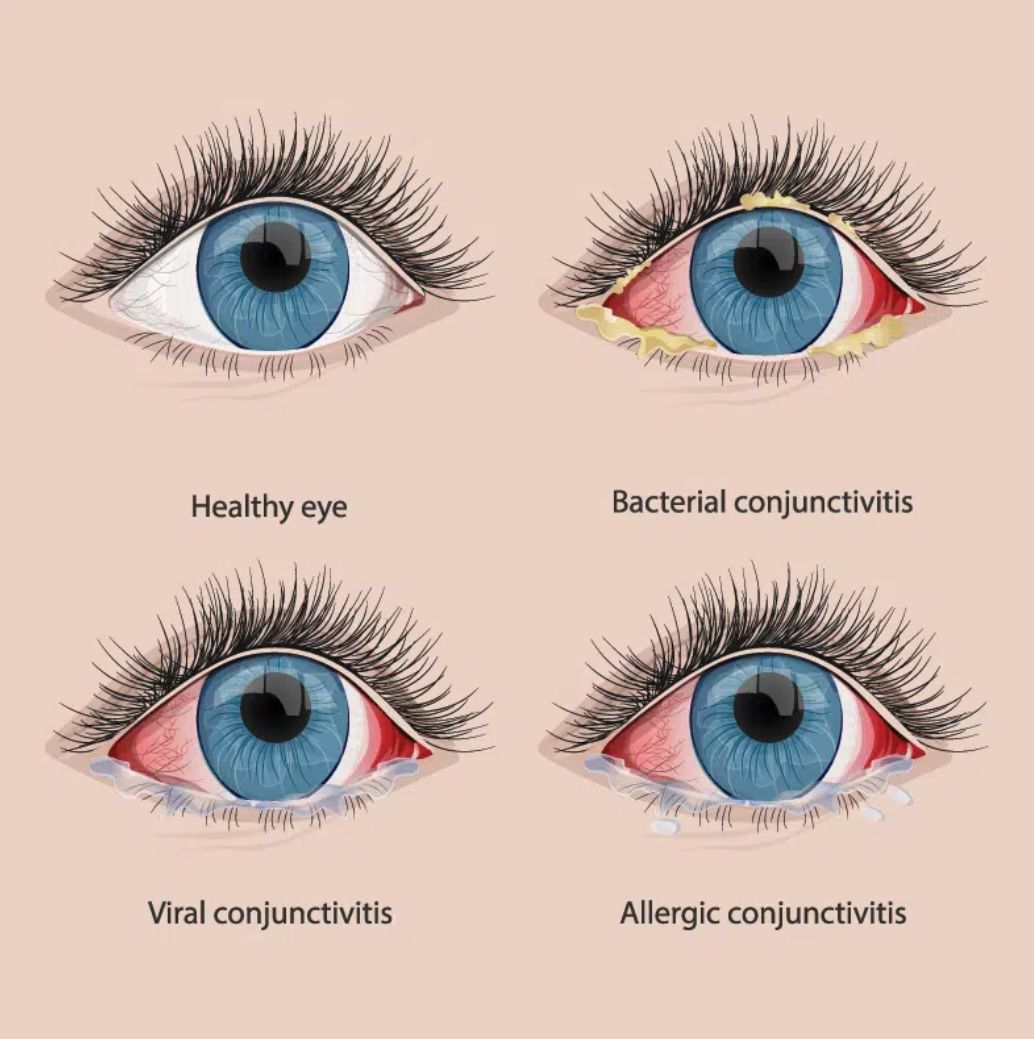Conjunctivitis, also known as “Pink Eye” or Madras Eye” is a highly prevalent eye condition that affects people of all ages. This inflammation of the conjunctiva, the thin clear tissue that covers the white part of the eye and lines the inside of the eyelids, can be caused by various factors. While conjunctivitis is typically not a serious condition, it can cause discomfort, redness, and temporary vision disturbances. In this blog, we’ll explore the causes, symptoms, types, and treatments of conjunctivitis.
Causes of Conjunctivitis
Conjunctivitis can be caused by different factors, including viruses, bacteria, allergies, and irritants. Here’s a brief overview of each:
1. Viral Conjunctivitis: This type of conjunctivitis is often associated with cold or respiratory infections. Viral conjunctivitis is highly contagious and can spread through direct contact with infected eye secretions. A variety of viruses, including adenoviruses, can cause viral conjunctivitis.
2. Bacterial Conjunctivitis: Caused by bacteria, this type can lead to redness, discomfort, and thick yellow or green discharge. Bacterial conjunctivitis can spread through direct contact or contact with contaminated objects. Most common bacteria include Streptococcus pneumoniae, Staphylococcus aureus, Haemophilus influenzae, Moraxella catarrhalis, or, it is also caused by, Chlamydia trachomatis and Neisseria gonorrhoeae (less commonly).
3. Allergic Conjunctivitis: Allergies to pollen, dust, pet dander, or other environmental allergens can trigger allergic conjunctivitis. It often results in itching, redness, and watery eyes. It is non-contagious.
There are two types of allergic conjunctivitis:
- Seasonal allergic conjunctivitis: This condition is linked to seasonal allergies, which typically manifest themselves in the spring and summer and occasionally in the fall. Seasonal allergic conjunctivitis is a condition brought on by exposure to pollen, grass, and other airborne allergens.
- Perennial allergic conjunctivitis: This condition lasts the entire year and is typically brought on by indoor allergens such as dust mites, pet dander, and mold spores.
4. Irritant Conjunctivitis: Exposure to irritants like smoke, chemicals, or foreign bodies can lead to irritation, redness, and discomfort. Unlike other types, irritant conjunctivitis is not contagious.
Symptoms of Conjunctivitis
The symptoms of conjunctivitis can vary based on the underlying cause. However, some common symptoms include:
– Redness in the white part of the eye or inner eyelids.
– Itching or a gritty sensation in the eye.
– Excessive tearing or watery eyes.
– Swelling of the conjunctiva.
– Discharge from the eye, which may be clear, yellow, green, or white.
– Sensitivity to light.
– Crusting of the eyelids or lashes, especially in the morning.
Treatment and Prevention
The treatment for conjunctivitis depends on its underlying cause:
Viral Conjunctivitis: Usually, this type clears up on its own within a week or two. Applying a warm compress and using lubricating eye drops can help manage symptoms. Steroids and antibiotics can be added based upon the severity.
Bacterial Conjunctivitis: Antibiotic eye drops or ointments may be prescribed to treat bacterial infections.
Allergic Conjunctivitis: Avoiding allergens and using antihistamine eye drops can help alleviate symptoms.
Irritant Conjunctivitis: Removing the irritant and using artificial tears can provide relief.
Prevention involves good hygiene practices:
Whenever you are suffering from conjunctivitis, you may prevent it from spreading to others by doing the following:
- Wash your hands frequently for 20 seconds with soap and warm water.
- Wash them thoroughly before and after cleaning your infected eye or applying eye drops or eye ointment to it.
- Avoid rubbing or touching your eyes. This could aggravate the situation or spread it to your second eye.
- Use different eye drop bottles or dispensers for your diseased and healthy eyes.
- Stop using contact lenses unless your ophthalmologist says it’s safe to do so again.
- Personal items such as washcloths, pillows, towels, makeup brushes, eye drops, eye or face makeup, contact lenses, contact lens storage cases, or eyeglasses should never be shared.
- Avoid using Swimming pools.
If you are in the presence of someone who has conjunctivitis, by taking the following actions, you can lower your chance of contracting an infection if you are around someone who has conjunctivitis:
- Wash and clean your hands frequently in warm water and soap for at least 20 seconds.
- If soap and warm water are not available, wash and clean your hands with sanitizer that contains at least 60% alcohol.
- After touching an infected person or the things he or she uses, wash and clean your hands.
- Avoid using unwashed hands to touch your eyes.
- Personal items such as washcloths, pillows, towels, eye drops, makeup brushes, eye or face makeup, contact lenses, contact lens storage cases, or eyeglasses should never be shared.

Leave a Reply